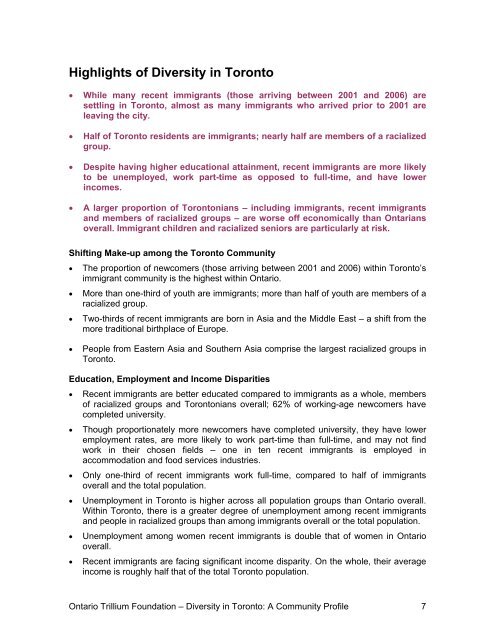Diversity in Toronto: A Community Profile
You also want an ePaper? Increase the reach of your titles
YUMPU automatically turns print PDFs into web optimized ePapers that Google loves.
Highlights of <strong>Diversity</strong> <strong>in</strong> <strong>Toronto</strong><br />
<br />
<br />
<br />
<br />
While many recent immigrants (those arriv<strong>in</strong>g between 2001 and 2006) are<br />
settl<strong>in</strong>g <strong>in</strong> <strong>Toronto</strong>, almost as many immigrants who arrived prior to 2001 are<br />
leav<strong>in</strong>g the city.<br />
Half of <strong>Toronto</strong> residents are immigrants; nearly half are members of a racialized<br />
group.<br />
Despite hav<strong>in</strong>g higher educational atta<strong>in</strong>ment, recent immigrants are more likely<br />
to be unemployed, work part-time as opposed to full-time, and have lower<br />
<strong>in</strong>comes.<br />
A larger proportion of <strong>Toronto</strong>nians – <strong>in</strong>clud<strong>in</strong>g immigrants, recent immigrants<br />
and members of racialized groups – are worse off economically than Ontarians<br />
overall. Immigrant children and racialized seniors are particularly at risk.<br />
Shift<strong>in</strong>g Make-up among the <strong>Toronto</strong> <strong>Community</strong><br />
<br />
<br />
<br />
The proportion of newcomers (those arriv<strong>in</strong>g between 2001 and 2006) with<strong>in</strong> <strong>Toronto</strong>’s<br />
immigrant community is the highest with<strong>in</strong> Ontario.<br />
More than one-third of youth are immigrants; more than half of youth are members of a<br />
racialized group.<br />
Two-thirds of recent immigrants are born <strong>in</strong> Asia and the Middle East – a shift from the<br />
more traditional birthplace of Europe.<br />
<br />
People from Eastern Asia and Southern Asia comprise the largest racialized groups <strong>in</strong><br />
<strong>Toronto</strong>.<br />
Education, Employment and Income Disparities<br />
<br />
<br />
<br />
<br />
<br />
<br />
Recent immigrants are better educated compared to immigrants as a whole, members<br />
of racialized groups and <strong>Toronto</strong>nians overall; 62% of work<strong>in</strong>g-age newcomers have<br />
completed university.<br />
Though proportionately more newcomers have completed university, they have lower<br />
employment rates, are more likely to work part-time than full-time, and may not f<strong>in</strong>d<br />
work <strong>in</strong> their chosen fields – one <strong>in</strong> ten recent immigrants is employed <strong>in</strong><br />
accommodation and food services <strong>in</strong>dustries.<br />
Only one-third of recent immigrants work full-time, compared to half of immigrants<br />
overall and the total population.<br />
Unemployment <strong>in</strong> <strong>Toronto</strong> is higher across all population groups than Ontario overall.<br />
With<strong>in</strong> <strong>Toronto</strong>, there is a greater degree of unemployment among recent immigrants<br />
and people <strong>in</strong> racialized groups than among immigrants overall or the total population.<br />
Unemployment among women recent immigrants is double that of women <strong>in</strong> Ontario<br />
overall.<br />
Recent immigrants are fac<strong>in</strong>g significant <strong>in</strong>come disparity. On the whole, their average<br />
<strong>in</strong>come is roughly half that of the total <strong>Toronto</strong> population.<br />
Ontario Trillium Foundation – <strong>Diversity</strong> <strong>in</strong> <strong>Toronto</strong>: A <strong>Community</strong> <strong>Profile</strong> 7

















